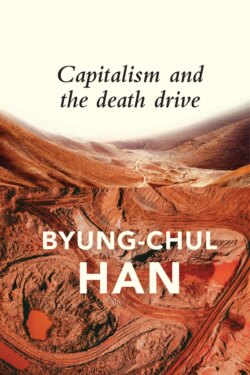Читать книгу Capitalism and the Death Drive - Byung-Chul Han - Страница 7
NOTES
Оглавление1 1. Walter Benjamin, ‘The Work of Art in the Age of Its Technological Reproducibility’ (Second Version), in The Work of Art in the Age of Its Technological Reproducibility and Other Writings on Media, Cambridge, MA: Harvard University Press, 2008, pp. 19–55; here p. 42.
2 2. Arthur Schnitzler, Aphorismen und Betrachtungen, Frankfurt am Main: S. Fischer, 1967, pp. 177f.
3 3. Sigmund Freud, Civilization and Its Discontents, New York: W. W. Norton, 1962 [1930], pp. 58f.
4 4. Transl. note: following James Strachey’s translation of Freud’s works, and according to Laplanche and Pontalis’s The Language of Psychoanalysis, the English term for ‘Todestrieb’ is ‘death instinct’. Here, I shall use the term ‘death drive’. There are two reasons for this: it is by now more common in general academic usage, and it allows retaining the difference between ‘Instinkt’ (instinct) and ‘Trieb’ (drive).
5 5. Gilles Dostaler and Bernard Maris, Capitalisme et pulsion de mort, Paris: Albin Michel, 2010, p. 9. [‘La grande ruse du capitalisme, nous le verrons, est de canaliser, de détourner les forces d’anéantissement, la pulsion de mort vers la croissance.’]
6 6. Sigmund Freud, Beyond the Pleasure Principle, New York: W. W. Norton, 1990 [1920], p. 46.
7 7. Ibid., p. 47 (transl. modified).
8 8. Ibid.
9 9. Freud, Civilization and Its Discontents, p. 66.
10 10. Ibid.
11 11. Ibid., p. 68.
12 12. Freud, Beyond the Pleasure Principle, p. 47.
13 13. Cf. Luigi De Marchi, Der Urschock: Unsere Psyche, die Kultur und der Tod, Darmstadt: Luchterhand, 1988.
14 14. Georg Baudler, Ursünde Gewalt: Das Ringen um Gewaltfreiheit, Düsseldorf: Patmos, 2001, p. 116.
15 15. E. S. Craighill Handy, Polynesian Religion, Honolulu: Bernice P. Bishop Museum Bulletin 34, 1927, p. 31; quoted after Elias Canetti, Crowds and Power, New York: Continuum, 1962, p. 251.
16 16. Adalbert von Chamisso, The Wonderful History of Peter Schlemihl, London: Peter Hardwicke, 1861 (transl. amended), at http://www.gutenberg.org/files/21943/21943-h/21943-h.htm (accessed 26 March 2020).
17 17. Jean Baudrillard, Symbolic Exchange and Death, Los Angeles: Sage, 1993, p. 127.
18 18. Transl. note: ‘denn er bringt das Leben ums Leben’. ‘Ums Leben bringen’ is an expression that also means ‘to kill’.
19 19. Erich Fromm, The Anatomy of Human Destructiveness, New York: Holt, Rinehart and Winston, 1973, p. 350.
20 20. Baudrillard, Symbolic Exchange and Death, p. 177 (transl. amended).
21 21. Ibid., p. 37 (transl. modified).
22 22. Norman O. Brown, Life Against Death: The Psychoanalytical Meaning of History, Middletown, CT: Wesleyan University Press, 1959, p. 284.
23 23. Georges Bataille, Eroticism: Death and Sensuality, San Francisco: City Lights Books, 1986 [1957], p. 239.
24 24. Ibid., p. 11.
25 25. Baudrillard, Symbolic Exchange and Death, p. 156.
26 26. Theodor W. Adorno, Philosophische Terminologie, Frankfurt am Main: Suhrkamp, 1974, vol. 2, pp. 181f.
27 27. Theodor W. Adorno, Minima Moralia: Reflections from Damaged Life, London: Verso, 2005 [1951], pp. 77f.
28 28. Sigmund Freud, ‘Thoughts for the Times on War and Death’, Standard Edition, Vol. XIV, London: Hogarth Press and the Institute of Psycho-analysis, 1957 [1915], pp. 273–302; here p. 299.
